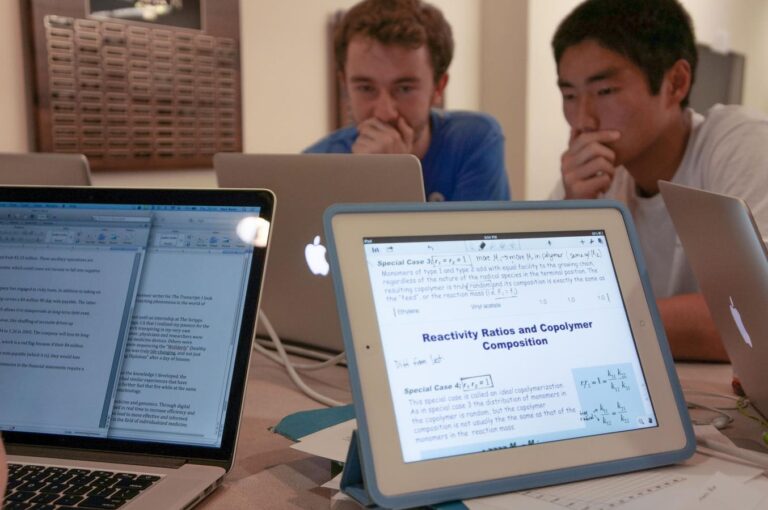Every company needs technology talent, making hiring a priority in economic development efforts
Students studying in the university library, 2016. By: Eric Chen (Photo by: JHU Sheridan) … [+]
According to the U.S. Bureau of Labor Statistics, technology jobs will be the fastest-growing jobs in the United States over the next 10 years, excluding health care. Data scientists (35% growth), information security analysts (32%) and software developers (26%) all rank in the top 10.
These are not surprising statistics, as technology increasingly permeates every aspect of daily life. However, as companies across all industries rapidly adopt digital technologies such as cloud computing and artificial intelligence, employers are finding it increasingly difficult to find technology talent and attract top talent. This has led to fierce competition.
Michigan employers are competing with traditional technology hubs in Northern California, Seattle, and Austin, Texas. But technology is important to all businesses, not just those that manufacture software and hardware. Consider the automobile industry. Modern cars and trucks are computers on wheels, equipped with automated driver assistance systems and large display screens, and run on ever-innovating software. The rise of electric vehicles will only accelerate the trend toward high-tech vehicles, as software replaces the complex mechanical systems found in internal combustion engines.
Beyond the auto industry, companies across the state are deploying artificial intelligence and other powerful technologies to drive innovation. For example, northern Michigan and the state's Upper Peninsula are home to a recreational technology ecosystem, also known as “rectech.” Biotechnology companies are emerging in West Michigan and Southeast Michigan. And companies are building supply chains to use clean hydrogen for transportation. Simply put, in 2024, every company will be a technology company.
As the need for high-tech workers increases, employers need to get creative with their recruiting strategies. Expanding the talent pipeline is also essential to economic development efforts.
Collaboration with higher education and employers
Successful talent development requires a proactive approach, which has three key parts. Graduate retention. and attracting out-of-state residents to fill job gaps. Before looking outside its borders, nations should always start by looking within and implementing settlement strategies. In Michigan, there are enough science, technology, engineering, and math graduates to fill the state's technology job needs. Michigan ranks in the top 10 in the nation for the percentage of higher education graduates with STEM degrees, but many leave the state for jobs in other regions with strong reputations for high-tech opportunities.
Employers in the state's lesser-known tech hubs need new approaches to attracting student talent and retaining it, so to speak. We need new approaches to successfully building relationships with students early in post-secondary and even early elementary school.
Employers and governments are working together to provide opportunities for STEM students to stay local after graduation. By collaborating with leading engineering institutions and employers, states can create a collaborative environment that benefits all involved.
- The Michigander Scholars Program provides scholarships of up to $10,000 to STEM students at participating universities who pursue degrees tailored to the needs of employers across the state. The winner will sign an employment contract with an approved company and commit to staying with that company in Michigan for her 12 months. Prospective students also have the opportunity to participate in special employer-student networking events and events. The state has funded 350 of her scholarships, and she has distributed 31 in the first three months of the program.
- Ohio is investing $70 million to upskill its workforce with an emphasis on technology credentials through the Investing in Ohio initiative.
- Semiconductor Research Corporation (SRC) is a high-tech research consortium of more than 25 companies and government agencies that offers doctoral fellowships through the Global Research Collaboration, improves educational opportunities at the doctoral level, and improves We provide an educated workforce.
- Louisiana's Fast Start Custom Employee Training Program provides free employee recruitment, selection and training for new and expanding businesses
meet students where they are
While scholarships provide important financial support, internships are valuable opportunities for practical experience and professional development that bridge the gap between education and employment. It's no wonder that companies in many industries are more likely to hire someone who has done an internship. In fact, according to Chegg Internships, 70% of employees at IBM, Google, Facebook, Deloitte, KPMG, EY, PwC, and the US Congress have completed at least one internship. More than half (57.6%) of interns converted to full-time employees in 2022, according to NACE's 2023 Internship and Co-op Report. Internships are the lifeblood of local, regional, national and global talent pipelines.
However, most internship programs are only available to graduates who go on to work, but according to Gallup, 41% of students have completed an internship while in college. Top candidates take advantage of internships and build relationships with potential employers while still in school, and some are hired as early as their first year, before they are offered a full-time position. There are some too.
One engineering school dean said that if incoming students don't have an employer in sight, they're already behind the curve. Even if a student does not participate in an internship between her freshman year and her sophomore year, the state can help by facilitating mentorship through matching and networking opportunities. Similar to the Michiganders Scholars Program, we will provide scholarships to sophomores and juniors who have accepted internships at partner companies, while also extending scholarships to seniors and graduate students who have received job offers from local companies. , you can further expand your student's location.
It is important to ensure that workforce development and talent retention programs align with the common needs and timelines of employers, workers, and educational institutions.
Recruiting top technology talent is increasingly similar to the recruiting efforts universities use to attract top high school athletes. Building relationships with students early on will help them stay in your state rather than looking for job opportunities across state lines.


